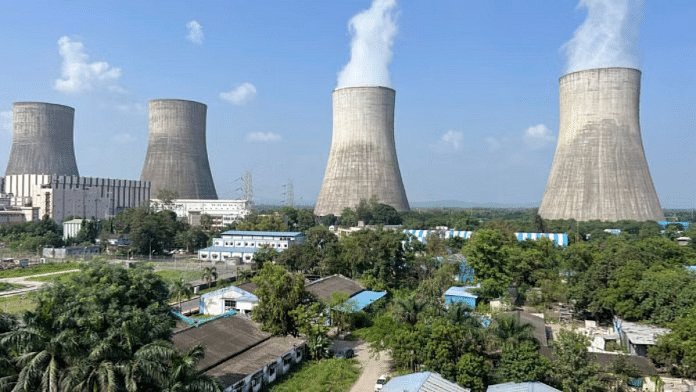New Delhi: The Centre has defended its decision to push the sulphur emission norms compliance for thermal power plants to 2027, saying that it is based on “extensive consultations” and “scientific studies.”
The notification, released Friday, postponed the compliance date for thermal power plants to install sulphur dioxide (SO2) emissions for the sixth time after the order was first passed in 2015.
This time, the Union Ministry of Environment, Forest and Climate Change (MoEFCC) also exempted 78 percent of the 537 existing thermal power plants from having to install the SO2 emissions regulation machinery at all.
Under the new regulations, only Category A power plants, which are 9 percent of total power plants—which are within 10 km of NCR or cities with million-plus populations—are mandated to install flue-gas desulphurisation systems (FGDs). For the Category B power plants, the FGD installations will be on a case-by-case basis, while Category C facilities, which make up 462 plants in total, have been fully exempted from installing these systems.
Despite the measure first being introduced in 2015, only 39 power plants in India have installed the FGDs as of 1 August 2024.
“Exempting a large number of thermal power plants—around 78 percent—and mandating emission controls on only 11 percent of India’s total thermal power capacity falls far short of supporting the country’s clean air goals,” said Shreya Verma, programme manager of industrial pollution programme at Centre for Science and Environment (CSE).
According to an MoEFCC note released Monday, the decision to exempt certain power plants from installing FGDs was taken after examining sulphur emissions from TPPs, air quality data from near TPPs, and the cost of installing FGDs. It said the total cost of installing FGDs in all of India’s power plants would be Rs 2.4 lakh crore, which is an investment that should be carefully ‘scrutinised’.
“Indian coal has very low sulphur content, and in many power plants the Ministry found that even without FGDs, the national ambient air quality standards were met,” explained Alok Kumar, former Union power secretary. “And given how FGDs increase electricity costs for consumers and also CO2 emissions, the government decided to only mandate it where necessary.”
Sulphur dioxide is one of the byproducts of coal and lignite thermal power plants, and is a ‘criteria pollutant’ according to CSE. An IIT Delhi study from 2022 describes how sulphur dioxide can turn to sulphate particulate matter during and after emissions, a main component of PM2.5. SO2 has been variously ascribed to different health effects like respiratory problems and lung disorders since 2005, both by Indian and international sources.
Most FGD systems use limestone or other alkaline products to remove sulphur dioxide from the gases released during the coal-firing process in power plants.
However, the MoEFCC said it is necessary to examine the issue in an Indian context. “Current exposure levels provide no credible evidence to suggest that SO2, under prevailing ambient conditions, is a major public health concern,” read the Ministry’s post on X.
The FGD compliance story, so far
The MoEFCC first decided to implement sulphur dioxide regulation norms in 2015, and gave thermal power plants until 2017 to install FGD systems. Thermal power plants make up 46 percent of India’s total electricity capacity, and 70 percent of electricity generation. An independent analysis by the Centre for Research on Energy and Clean Air in 2024 revealed that India was the largest producer of SO2 from electricity generation.
In 2022-23, the study showed that coal power plants produced 4327 kilotonnes of SO2, which was 240 times more than what was produced by burning 8.9 million tonnes of paddy.
A CSE factsheet describes that the power ministry in 2015 put forth a new plan to extend the emissions compliance deadline to 2024, and was granted an extension until 2022. Since then, the deadline has been extended three more times, before the 11 July order, which extended it for the sixth time after “consultations with stakeholders and research institutes.”
According to the MoEFCC’s note, 94 percent of the coal used in the power plants is domestic coal, which only has 0.5 percent sulphuric content, much lower than the coal used elsewhere. It also said that 490 out of 492 cities monitored in 2023 were within the prescribed SO2 levels in their ambient air quality levels.
“Government sources have said that Indian coal has low sulphuric content, but they also say it has low calorific value, so more coal is needed to produce the same 1W of electricity. This increases SO2 production, too,” said Verma. “Also, SO2 is a problem because it gets converted to sulphate matter, which forms PM2.5. That happens over a long period and has transboundary impacts.”
The Ministry’s note pointed to a 2024 IIT Delhi report, which says the contribution of sulphate to PM2.5 and PM10 is between 2 and 6 percent, and that FGD installations in power plants would only result in a “marginal improvement” of air quality.
However, this study directly contradicts the 2022 study conducted by the same team, which had said installing FGDs would decrease surface sulphate aerosols even in areas 200 km away from the power plants.
“It is very worrying that the number of people who may suffer or die is not being acknowledged or addressed in any of the reports. Scientific articles showed that coal-fired power plants led to 47,000 deaths in 2014, 62,000 deaths in 2017, and 78,000 deaths in 2018,” reads an article by the Centre for Research on Energy and Clean Air (CREA) in 2025.
However, the Ministry said it is committed to a “comprehensive, science-based strategy” for air quality management, and that regulations for SO2 control should not be dictated by “rhetorical observations” but by real-time impacts on PM2.5.
(Edited by Tony Rai)
Also Read: Union Carbide waste is now ash. But Pithampur residents aren’t convinced that it’s no longer toxic






